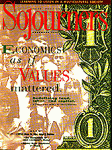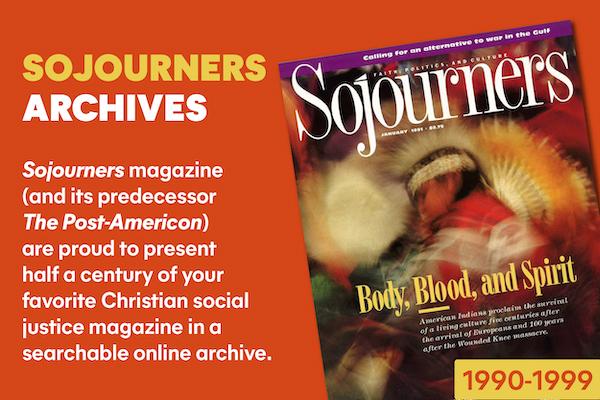The heart pours forth what it cannot hold,
A living spirit of purest love.
- Howard Thurman
A shimmering explosion. Billowing sheets of sound wrapping themselves around us. The highest sound I know. The music of John Coltrane.
For some, the work of the late jazz saxophonist John Coltrane conveys the voice of God, the holy vibration of the Divine, the aural Love Supreme. An AME Zion church in San Francisco has even been dedicated to him and his music.
For others, Coltrane's distinctive sound is unbearable--squawking, roaring, unsettling, and overwhelming. And, no doubt about it, Trane's music does have an intensity that isn't easy on the ears of the uninitiated.
Both reactions were obvious when the great historian of the civil rights movement, Dr. Vincent Harding, unleashed a long Trane set as part of his Sunday morning sermon at Sojourners' 20th anniversary festival in 1991. Conference participants squirmed in their seats as powerful waves of breathless sax lines poured over them. Quintessential Coltrane, the solo was a long (very long to some) run of exceedingly complex chordal progressions, blurred sixteenth- and thirty-second-note scales, and wailing expressions of soul, concluding with a heartfelt improvisation of "Amazing Grace."
This song's meaning was consistent with the other activities of the conference--breaking out of old patterns and discovering new perspectives. Harding's offering of Coltrane to the largely white crowd was a doxology of sorts, a sending forth into a world of dissolving paradigms and an uncertain future. Indeed--unknown to those present--at the same moment the Trane tune was presented to the Sojourners audience, hard-liners in the Soviet Union attempted a coup to unseat Mikhail Gorbachev and end his reforms, and the Cold War polarization of the world as we then knew it began to thaw.
John Coltrane and his music signified a freedom which was at the heart of America's own efforts at reformation during the civil rights era--a freedom movement that was played out in cultural realms as well as the social and political. "This consciousness," writes one Coltrane biographer, "was striving to be free of the low American cultural state as well as the perverted value system" of racism.
As Harding writes in his book Hope and History: Why We Must Share the Story of the Movement, "[Coltrane's] life joined the lives of all the world's best freedom workers in their recognition that freedom is fundamentally a means to humane development....And who with soul could not respond?"
The recent release of three new Coltrane collections, A John Coltrane Retrospective: The Impulse! Years, The Last Giant: The John Coltrane Anthology, and Live at the Five Spot Discovery! marks an important contribution to the understanding and appreciation of one of jazz music's most innovative and influential artists. However, beyond John Coltrane's artistic and technical skills on the tenor and soprano saxophones is an extraordinarily spiritual soul that is carried through the music. Though it has been nearly 25 years since Trane succumbed to liver cancer at the age of 40, the profound devotion and higher calling found in his music continue to convert and revive many new and old fans to liberating perspectives and a deepening of their faith.
THE IMPULSE! YEARS covers 1961-1967, the last era of Coltrane's recording career, certainly his most experimental period, and arguably his most powerful and productive as well. This three-disc collection includes some of his strongest compositions, including "Greensleeves," "Miles' Mode," "Chasin' the 'Trane," and a redux-version of the artist's reportedly favorite tune, "Naima." The Impulse! Years also features appearances and compositions by the great Duke Ellington, vocalist Johnny Hartman, and the recently departed Billy Eckstine.
One of the most powerful tunes included in this collection is "Alabama" (also featured in Spike Lee's Malcolm X), Coltrane's profound--and haunting--elegy for the four black children killed in the bombing of a Birmingham church in 1963.
Coltrane's strong religious upbringing in the High Point, North Carolina home of an AME Zion minister inspired the artist throughout his life. "Spiritual," an extremely moving, 13-minute live performance, captures the powerful call-and-response tension that is the emotional essence of the Negro spiritual. Featuring a solo by the multitalented musician Eric Dolphy on bass clarinet, the song is a mournful cry for liberation and a celebration of faith in God.
In the later years of Coltrane's career, he created several extended masterpieces based on his spiritual ideas, including A Love Supreme, which was named Down Beat's record of the year in 1965. Recorded as a "humble offering," Trane later said that the whole album, beginning to end, came to him as a vision of God.
The Impulse! Years includes part one of this composition, "Acknowledgement," a richly transcendent and noble piece that, in part, recounts Coltrane's spiritual awakening and his recognition that "it is all with God." Unleashed by the powerful drumming of Elvin Jones, "Acknowledgement" rises and falls to the hypnotic piano of McCoy Tyner and the pulsating bass of Jimmy Garrison, closing with a plaintive chant of strong devotion. After A Love Supreme, Coltrane said that 90 percent of his playing was actually prayer.
Much like the tongues of angels referred to in 1 Corinthians, Coltrane's musical explosions expressed ideas and emotions that were inexpressible in any other way. "He abandoned the song as a necessary point of departure," wrote noted jazz author Phyl Garland, "and opened up the music, enabling it to move in all directions, filling spaces with incredible flurries of notes not always related to any set pattern or form. As his voice called out for a new freedom, others were impelled to answer their own inner voices."
THOSE WHO CAN'T afford this three-CD collection may find a gem in another new release featuring the music of John Coltrane. The Thelonious Monk Quartet Live at the Five Spot: Featuring John Coltrane is a newly discovered recording from Coltrane's short stint in 1957 with jazz master Thelonious Monk (see "A Living Institution," April 1990). Though crudely recorded by Coltrane's wife, Naima, with a single microphone, portable recorder from the floor of New York's Five Spot nightclub, this historic release reveals Trane at an extremely powerful and formative stage under the tutelage of the more accomplished Monk.
Rhino Records is also climbing aboard Trane's reborn popularity with its 1993 release The Last Giant: The John Coltrane Anthology. This two-disc retrospective covers Coltrane's music from his first studio session to his years with Atlantic through the 1950s. Representing a rawer (and somewhat more soulful and earthy) John Coltrane than the more exploratory and spiritual Trane of the Impulse! release, The Last Giant is the Trane of High Point church pews and the factories and fields of North Carolina. It flows from the worn reeds and years of sweaty discipline in Philadelphia apartment flats, where Trane mastered his technique note by note--silently fingering the keys of his sax late into the night while his cousin Mary slept in the next room.
Disc one opens with "Hot House (Jam Session)"--for which Coltrane broke the segregation of the U.S.'s World War II armed forces to record with his Navy shipmates--and concludes with the best-known Trane of them all, the 1960 recording of Rodgers and Hammerstein's "My Favorite Things." Between these two, Trane's ascending career is tracked as he rises with the stars, playing in the bands of Dizzy Gillespie, Johnny Hodges, Miles Davis, and Thelonious Monk.
The majority of the compositions found on the second disc were recorded during a time of significant self-discovery for Trane...as a musician and a human being. It was during this period that Coltrane overcame his addiction to heroin and experienced, in his words, "a spiritual awakening which was to lead me to a richer, fuller, more productive life." Featuring Coltrane classics such as "Central Park West," "Equinox," and "Giant Steps," disc two of The Last Giant also uncovers a previously unreleased jewel, a 25-minute live version of "My Favorite Things," mingling Trane's explosive soprano with the savvy sweetness of Eric Dolphy's flute.
In addition to being an excellent and historic retrospective of John Coltrane's work, this premier release of the Rhino/Atlantic Jazz Gallery--a new series that will present retrospectives of the music's masters--has also moved CD marketers to a new level of creativity in packaging. The two CDs are beautifully bound in a small cloth case with a photo-filled, 51-page biography of Trane by jazz scholars and those who knew him.
John Coltrane was, among musicians, a pearl of great price. Nearly every personal account depicts Trane as an extremely quiet, gentle, and humble man of great--though intense--inner serenity.
His support for younger musicians and willingness to share the spotlight with them was consistent throughout his career. He passionately delved into the world of musical traditions, incorporating the scales, tones, and soul of Indian, Middle Eastern, Asian, and Western classical music into his own style; and in doing so, expanding the breadth of American jazz.
In Coltrane, Harding notes, was found "that dual tendency which marks the lives of all seekers after new realities--the prophetic urgency to break open possibilities and vistas not yet explored, and the priestly longing to carry out the healing of the fractured communal will."
Especially for those who believe that music has the power to set the captives free and open up new avenues for revelation, Trane's sound carries a certain poignancy you would be hard pressed to find elsewhere. But watch out--once you develop an ear for what Harding calls "a music more powerful, more anguished and celebratory than any in recent memory," you may never be the same!
This is the American classical music that makes it possible for us to broaden our vision, remembering to, as Howard Thurman wrote, "Keep open the door of thy heart. It matters not how many doors are closed against thee."
Aaron Gallegos was an editorial assistant of Sojourners when this article appeared.

Got something to say about what you're reading? We value your feedback!
